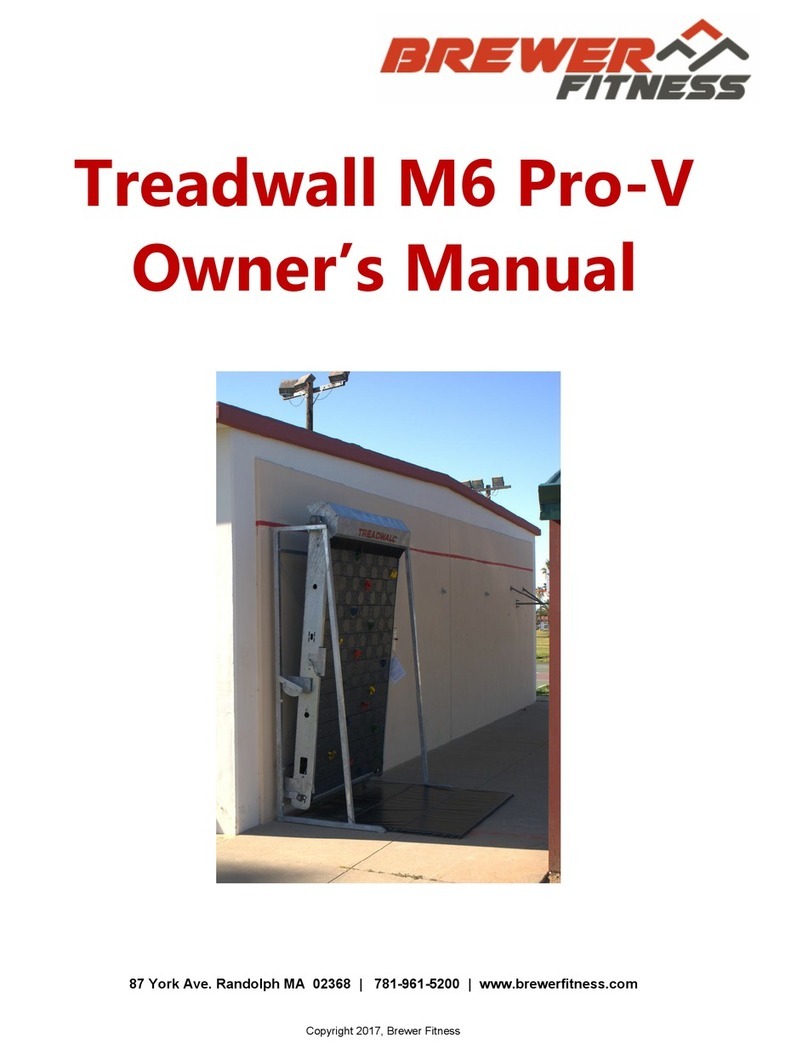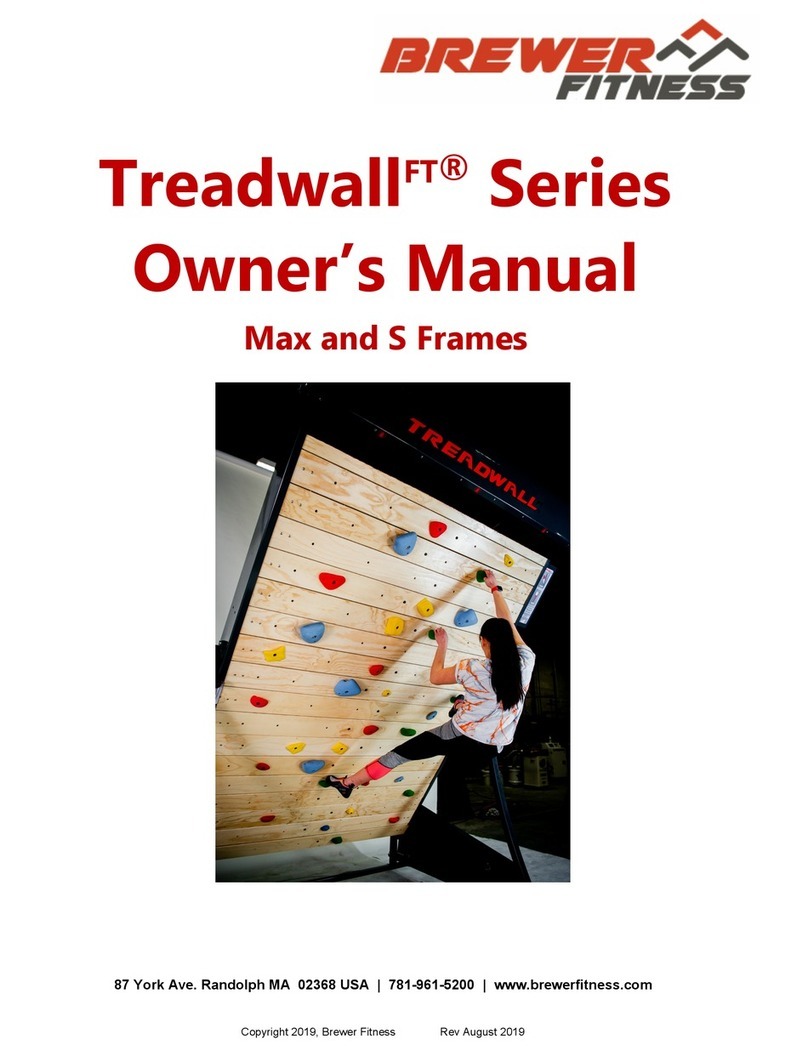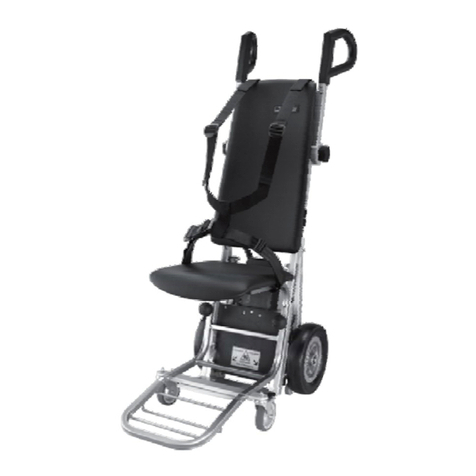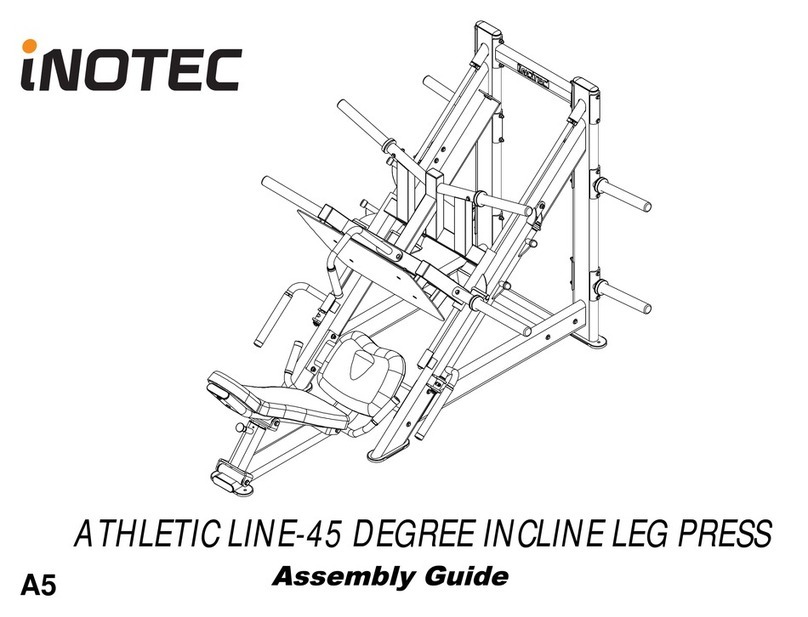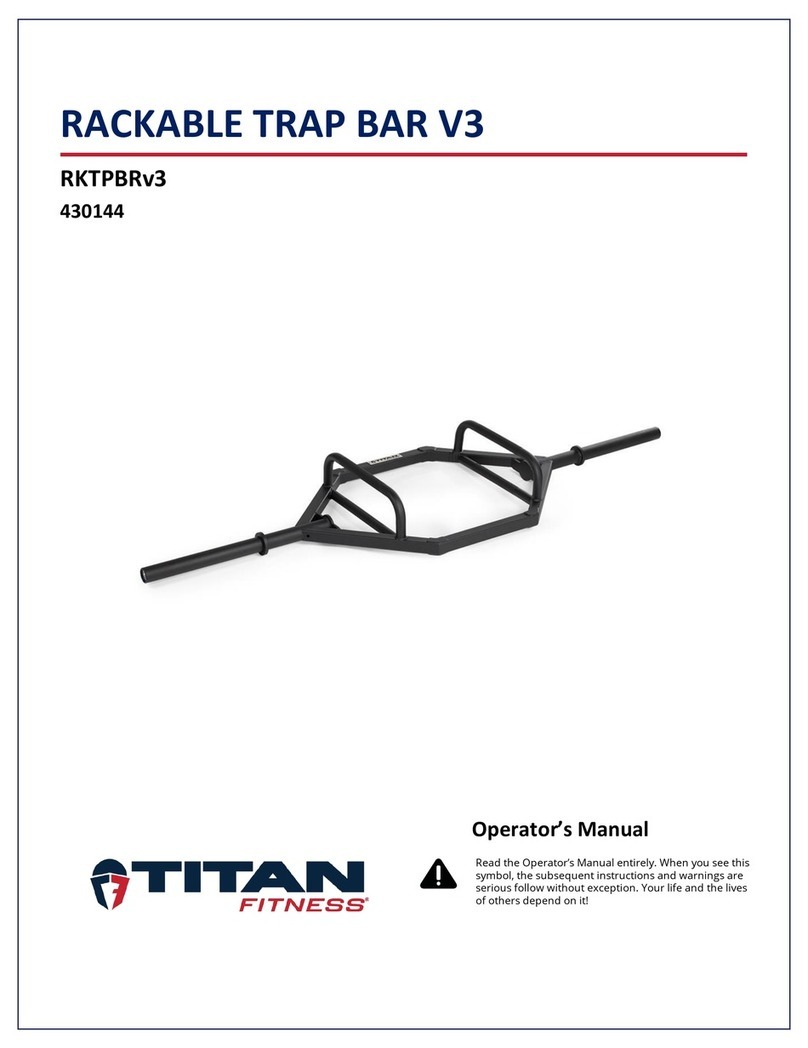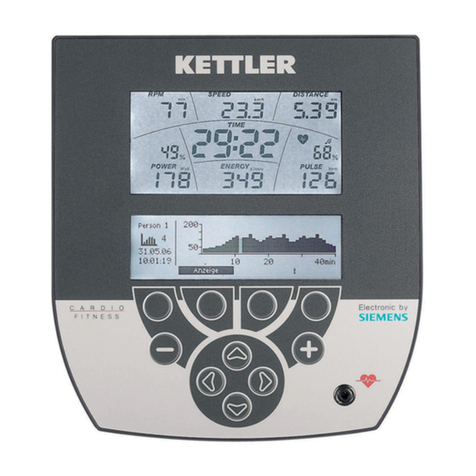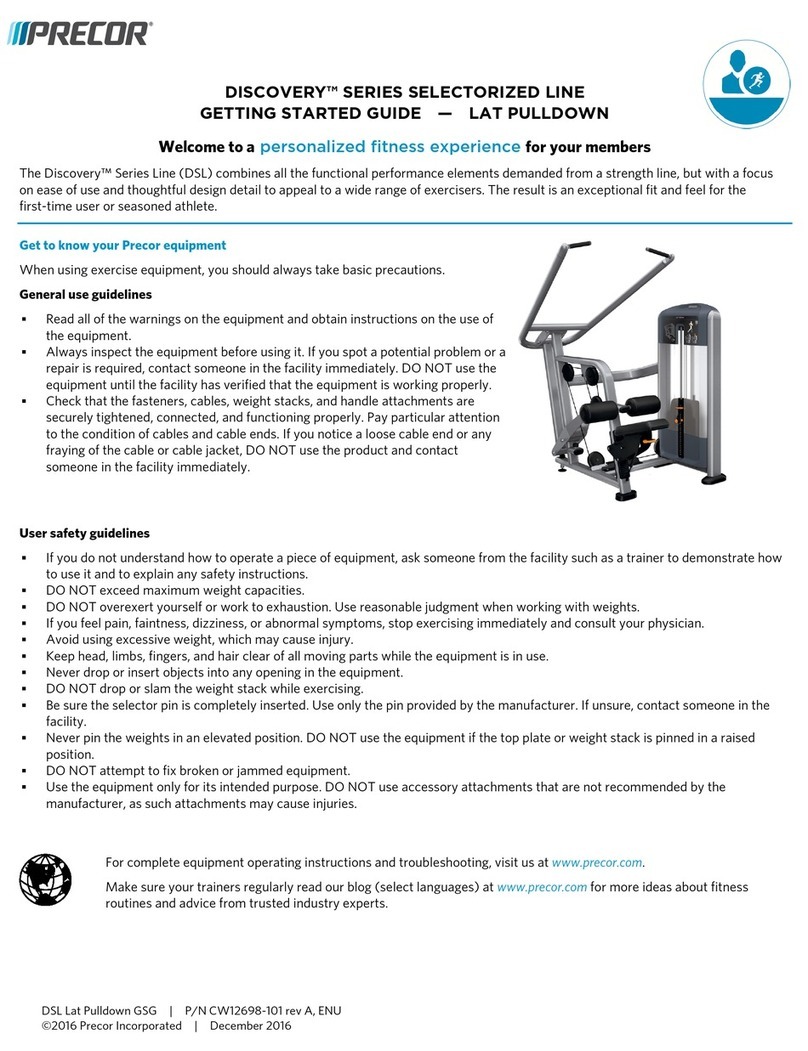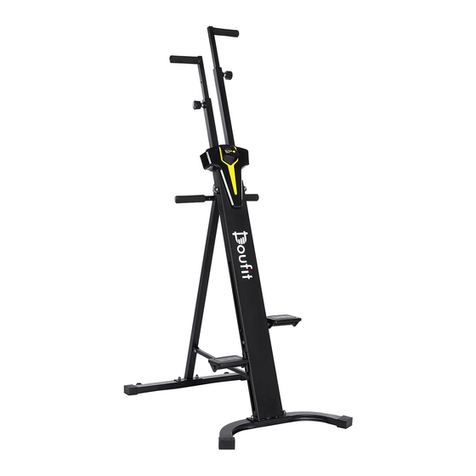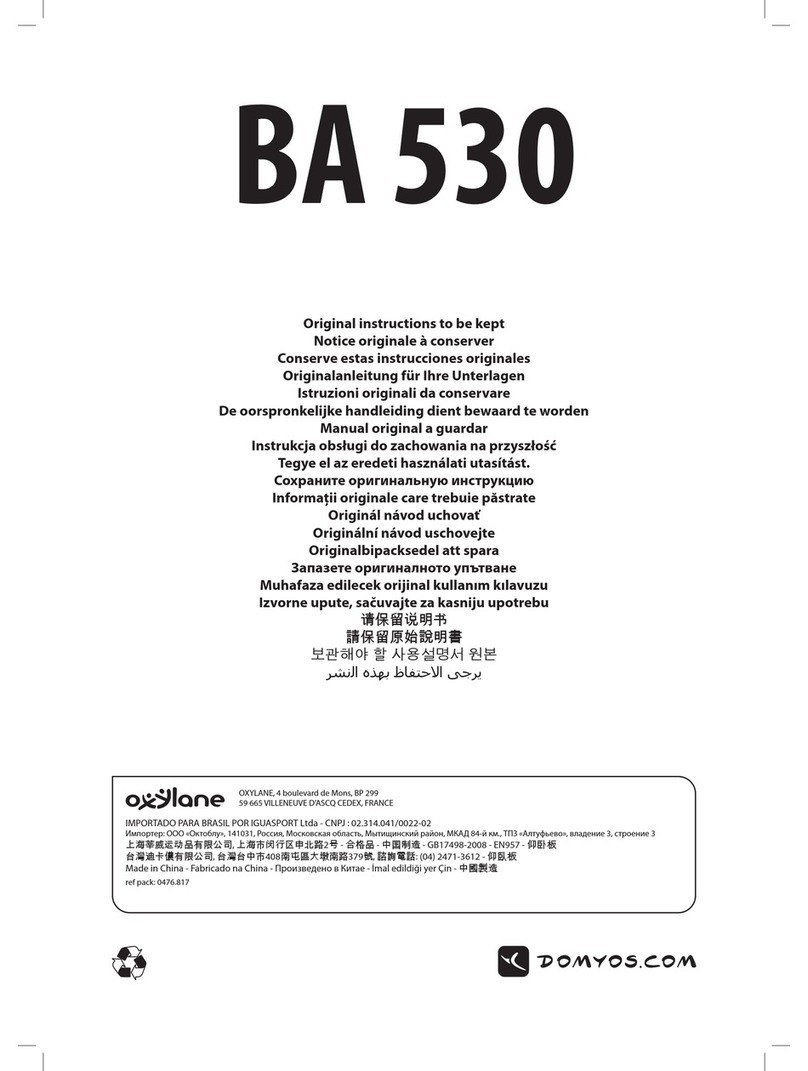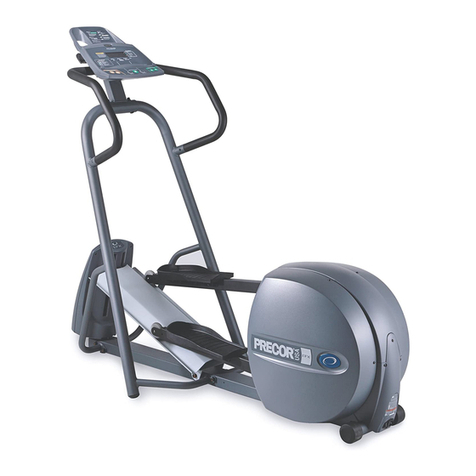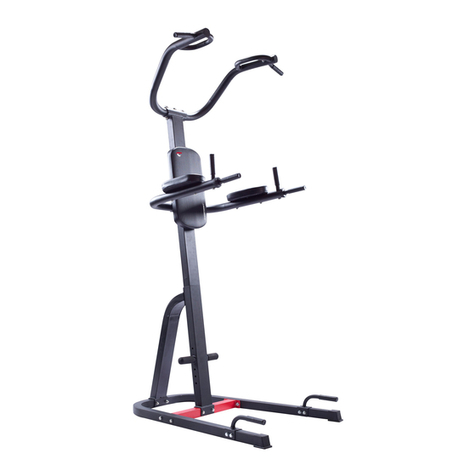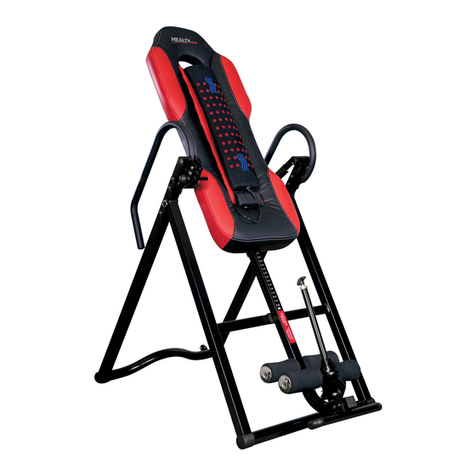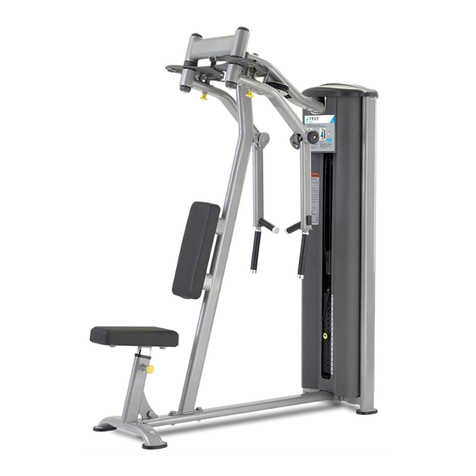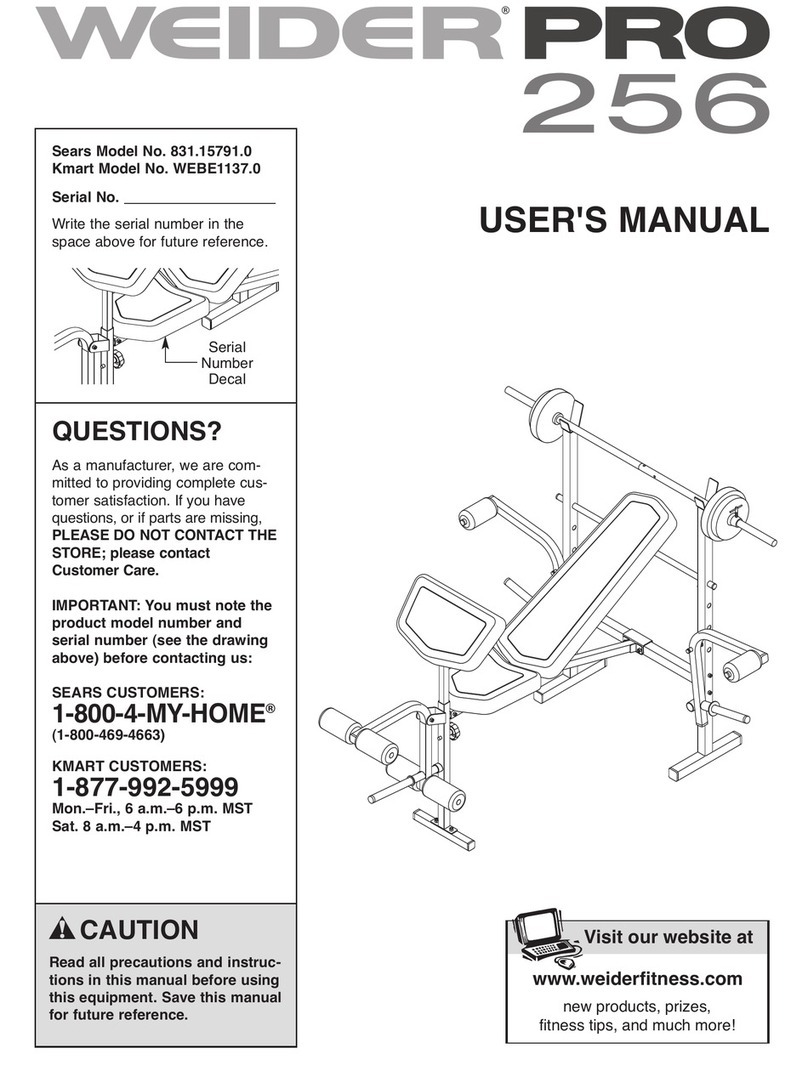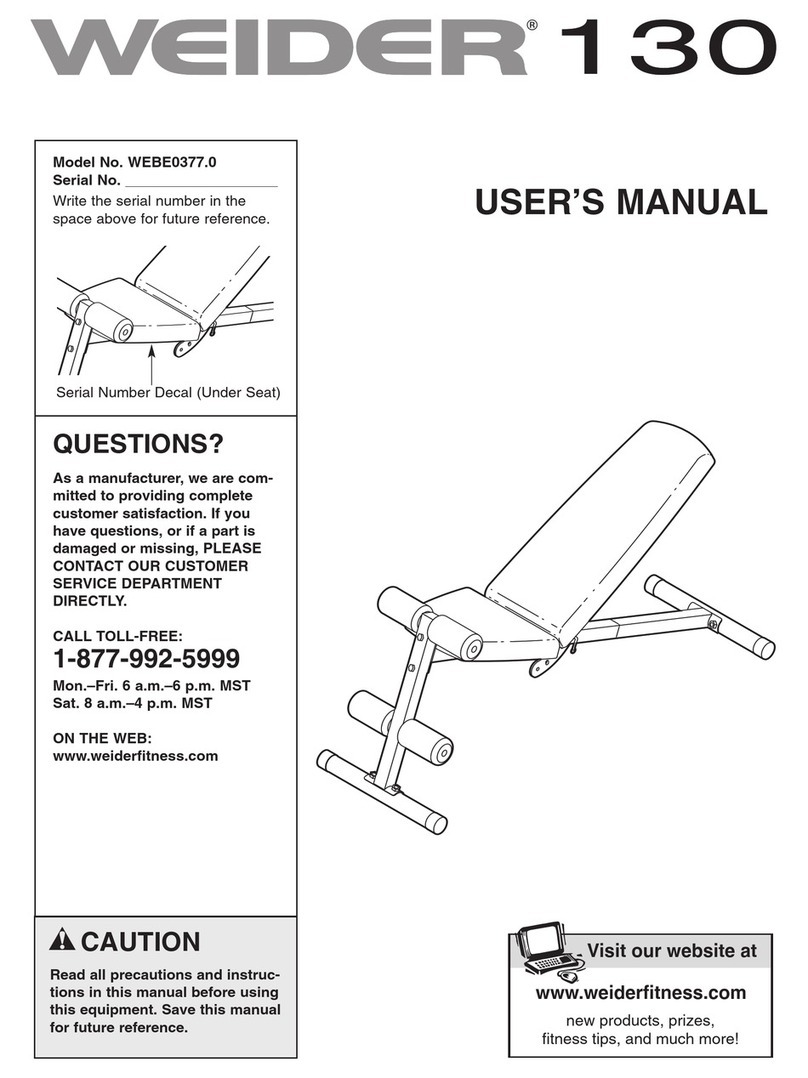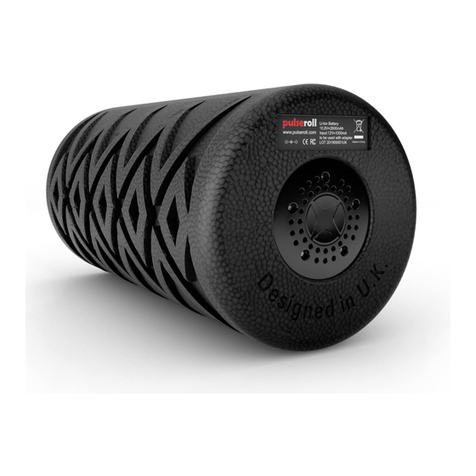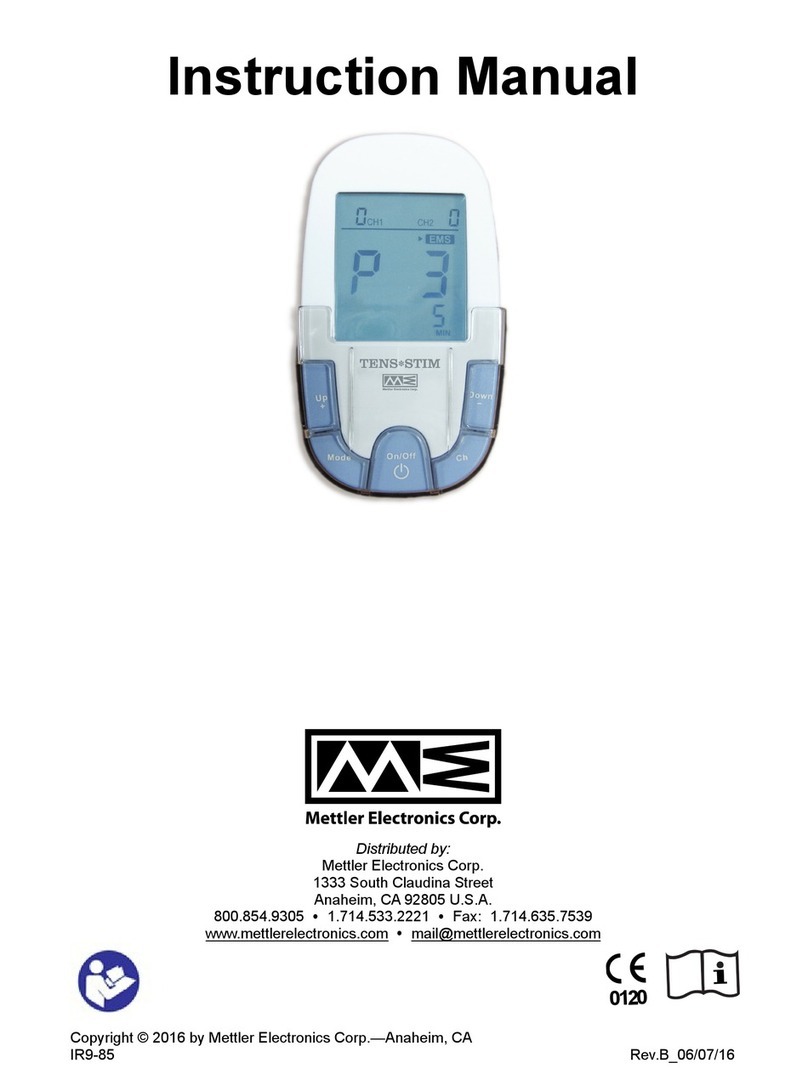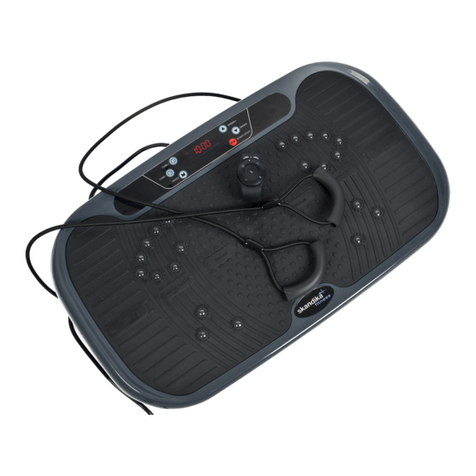Brewer Fitness Laddermill Ascender User manual

Laddermill® Ascender
Owner’s Manual
87 York Ave. Randolph MA 02368 | 781-961-5200 | www.brewerfitness.com
Copyright 2017, Brewer Fitness


i
Laddermill Owner’s Manual—2017
Table of Contents
Introducon / Registraon 1
Safety ps / Specificaons 2
Operang Instrucons 3
Making Your Laddermill a Success 7
Informaon for Your Staff 8
Training Tips/Guidelines 9
Acvies & Promoonal Ideas 11
Frequently Asked Quesons 13
General Maintenance 15
Troubleshoong 17
Service Instrucons 18
Assembly instrucons 23
Channel Assembly 24
A frame Assembly 27
Glossary 31
Warranty 32
Contact Info 34
Laddermill
Complete Owners Manual

ii
Laddermill Owner’s Manual—2017

1
Laddermill Owner’s Manual—2017
INTRODUCTION
Vertical movement is a new category of training that works the whole body and mind together. The Laddermill
will deliver a remarkable aerobic burn that anyone can “enjoy.” While simultaneously challenging the upper-
body, core and grip strength, exhausting even the fittest athletes. When introducing the wall, we suggest the
staff understands its potential, benefits and how to use it as a fitness tool.
The Laddermill will enhance any user’s routine with its revolutionary, simple design. A wide array of muscle
groups are recruited when using the equipment, providing a full body workout. The ability for the machine to
change angle and very speed allows personalized use for any ability level. During this exercise you may be
surprised how quickly your strength and cardiovascular endurance are tested.
The owner’s manual is designed to provide the purchaser with the resources needed to make the most of this
equipment. It will provide information and sources for programming ideas, some simple and others more
complex.
The workout is effective, fun and customizable, so now it is up to you all to extend the knowledge to your
members and get them to try it out! Once the initial attempt is out of the way people will see for themselves
what a workout it can be.
PRODUCT REGISTRATION
Record your serial number here:________________________________
Please visit brewerfitness.com/OwnersManual to register your new Laddermill with us.
You can also email us at sales@brewerfitness.com with your contact informaon and serial
number to complete your product registraon.
You must make sure to register your new Laddermill to receive service updates.

2
Laddermill Owner’s Manual—2017
Safety Tips
Safety Tips
WARNING - Read all instrucons before assembling and using the Laddermill.
For Assembly:
Be careful when moving and installing the Laddermill, it requires effort to li and aach the
main channel. Some steps require 4 individuals. Have 3 people assist you during assembly and
make sure to have two ladders on hand. The heaviest components need to be lied to a
vercal posion.
For General Use:
Carefully read and understand the Laddermill Owner’s Manual. Provide a general overview of
the basic operaons and usage to new Laddermill users. Do not place other equipment or any
items in the fall zone.
Laddermill Specificaons
Weight 590 Pounds
Dimensions 66” wide x 54” deep x 118” tall
Width of climbing surface 30” feet
Length of climbing surface 20 feet
Number of Rungs 20
Angle Range Posive 10 degrees to negave 20 degrees
Electrical Requirements 9 V DC Plug-in Transformer
Electronic Display Measures Distance in feet, me, and calories

3
Laddermill Owner’s Manual—2017
Operang Instrucons
INTRODUCTION
There are 3 primary controls to know about on the Laddermill. You can adjust the speed of the climb with
the lever located on the right side of the machine, you can adjust the angle of the wall with the lever on
the le side of the machine, and you can view and track the stats on your exercise with the digital
counter on the right side of the machine.
HOW THE LADDERMILL WORKS
It’s very simple, you can just hop on and climb! The weight of your body will move the rungs
downwards. With our auto-stop technology, if you stop climbing, the Laddermill will stop and wait for
you. The Laddermill will not move unless you are on the wall and climbing upwards.
You can adjust the angle of the wall as well, which makes it easy to cater to a large variety of abilies
and fitness goals. Easier angles are great for aerobic workouts and focus on the lower body.
Overhanging angles require a lile more upper body strength and really engage the core.
Use the digital counter to set goals, manage your progress, and track your exercises. The counter will
begin automacally counng upwards when you start climbing, or you can set me and distance goals
on the setup screen.
Speed Lever
Digital Counter
Angle Change Lever
Control Mechanisms

4
Laddermill Owner’s Manual—2017
Operang Instrucons
Speed Control
To control the speed of your climb you simply move the
lever up and down. At the “0” seng the Laddermill will
be completely stopped for most people or it may just
barely creep downwards for heavier individuals. At speed
“10” the wall is at its fastest and only requires about 50
pounds of weight to move. The ideal seng will be
different for people of different weights.
Accurate current and average speeds are displayed on the
counter in feet/min. or meters/min if needed.
Angle Changing
To change the angle of the Laddermill you
begin by moving the angle lever downward.
A range of 10 degree posive to 20 degrees
negave is available to you and you can stop
anywhere in the middle.
For a negave angle you need to be standing
on the Laddermill. Your body weight will
move the Laddermill slowly to a negave
angle. You can stop at any me by leng go
of the lever.
To return to a posive angle step off the
machine and move the angle lever
downward. The Laddermill will move
forwards returning automacally to a
posive angle.

5
Laddermill Owner’s Manual—2017
Operang Instrucons
Digital Counter
The counter will start counng as soon as you start climbing. It will pause if
you rest for 5 seconds, and it will power down aer 5 minutes of non-use.
To turn the counter back on just start climbing, or tap the screen.
You can adjust the view angle by adjusng the small arm at the rear of the
counter.
Adjustment knobs
0
Calories
Time
0
Distance
0
Speed
0
Average Speed
Reset
Setup ?
Done
Distance Goal
?
Time Goal
Hold buttons above for
distance and time goals
Enter weight
below for
0
00:00
0
1 2 3 4 5
6 7 8 9 0
Clear
Home Screen
The home screen shows real-me data for a single climb. When you
pause for 5 seconds the counter will hold your data on the screen unl
you begin climbing again and then it will start from where you le off.
To reset the counter for a new climber hit “Reset.”
Setup Screen
To set a distance or me goal tap or hold the buons labeled
“Distance Goal” or “Time Goal”. The values will increase more
rapidly as you hold the buons down longer.
The number pad allows you to enter your weight for a more accurate
calorie count. The default weight is 150 pounds. When you are
sasfied with your goal hit done and the value you selected will
appear on the home screen.
You can only select a distance or a me goal, not both at once.

6
Laddermill Owner’s Manual—2017

7
Laddermill Owner’s Manual—2017
Making Your Laddermill a Success
Groundwork:
Staff should understand that vertical movement is a basic human activity, non-contrived and part of
everyday life. It should be presented a positive addition to the facility
Climbing will often be perceived as challenging and intimidating activity. A staff locked into the value
of vertical movement as a fitness tool is the key for changing this perception. Members should be
actively encouraged to try the Laddermill and consider it for part of their workout routine. We have
found that people who are initially hesitant often end up being the biggest Laddermill fans.
Choosing an Advocate/Integration
When the Laddermill is first installed, it will be an unfamiliar item. Climbing will be a relatively new
training activity for most. We recommend that a staff person be chosen as the main advocate for the
product’s introduction period. This person might take on the following responsibilities:
1. Read through the manual thoroughly and familiarize his/herself with the Treadwall operation
procedures, use and set-up.
2. Formulate a plan to integrate this equipment into their classes, personal training or general us-
age.
3. Creating challenges, competitions (joining our Everest Program), fun ways to get your members
hooked on Vertical Movement
Set up a meeting with trainers to Establish Goals and Discuss Ideas:
1. Cross-training for sports that emphasize forearm strength such as martial arts, baseball, swim-
ming and tennis.
2. Weight-loss programs. Focus on manageable goals, using easier positive angles. Emphasize
smoothness over speed.
3. For Cardiovascular try 15 minutes once a week or every two weeks in place of a treadmill.
4. As a warm-up, especially for lifting. Suggest using ground-based training (hands only) for larger
lifters.

8
Laddermill Owner’s Manual—2017
Informaon for Your Staff
The Benefits of Vertical Movement:
most valuable
Most fitness activities target isolated muscle groups, but vertical movement is different. Using a
Treadwall provides a full-body, non-repetitive exercise that can be adapted by the user for different
goals. You can customize the experience by adjusting the exercise patterns, angle and/or speed
on the wall. In terms of focus and mental involvement, climbing has no peer. The activity requires
constant decision-making and concentration. This promotes a quick motor response and muscle
recruitment. Technique, balance and core strength interplay and climbers often develop a height-
ened sense of body awareness and confidence in their daily lives.
The Laddermill can be used by itself by performing intervals, for circuit training with other equip-
ment or longer periods for pure endurance. It is a low-impact full body workout which makes it an
ideal complement to other fitness activities and sports. It can be used as a warm up, cool down or
a high intensity programming.
Customize it to suit YOUR needs and GOALS.
1) You should use the equipment yourself to get a first-hand look at how the workout makes you
feel, learning to access angle/speed for a variety of abilities and to reap the benefits of vertical
movement personally.
2) At first this equipment may be considered intimidating, but the more knowledge you can pass
on to your members about training and benefits will help bridge the gap.
3) Check out all the different ways it can be used (varying hand grip, angle and body movement)
--- to keep it engaging to the user. Be creative.
Encourage Members to Try It Out:
They should try it at a positive angle first so they can get familiar with the balance and motions in-
volved. Try the workout on the
Quick Start
with them if you need a reference.
Emphasize controlled, smooth movement and attention to balance.
Suggest short workouts to start, which will complement their current workout routine

9
Laddermill Owner’s Manual—2017
Below you will find different training tips we have learned over the years to ease your
clients in to Vertical Movement.
Initial Exposure: When one of your clients/members are trying out the Laddermill for the first time.
KEEP IN MIND.
1. Ensure speed is on zero before having them climb
2. Ask if they would like you to control speed at first.
3. Tell them to climb up closer to the top of the wall before adjusting speed
**Then see if they want to try controlling it on their own (*Useful to tell them that speeds 7 to
10 are usually much faster, so move lever slowly up when increasing speed*) All they have to do is
hang on and reach for the speed lever and pull it up a small amount
4. Have them take it slow at first and focus on smooth movement
5. Emphasize the need to move your feet above the stop bar at the bottom of the machine
6. Tell them they can keep going even after the stop bar has engaged, just keep climbing up and it
will continue to rotate
Initial Workouts/Resources:
1. Try having them start on the slow for 1 or 2 minutes to get a feel for the movement
**Add Push-ups in between rest or a core exercise (SHOW THEM WHAT IT IS ABOUT)
2. As they continue to climb suggest mixing up the grip positions and body positions plus angles
Training Tips/Guidelines

10
Laddermill Owner’s Manual—2017
QUICK HINTS:
1. Start them slow, remind about auto-stop sensor panel
2. Focus on Safety (tell them to ride the wall down there is a stop sensor no need to jump from the top)
3. Tell them they are not very high off the ground if they seem reluctant
4. Mention the benefits of Vertical Movement so they are aware of WHY they should use the equipment
Full-Body/Burn Calories/Lean Muscle/Core Strength
1. Refer www.brewerfitness.com/ownersmanual for downloadable versions of the Quick Start, Training Logs, re-
sources for articles on the benefits of climbing etc.
2. Refer to our website for full training program ideas and short workouts
3. You may also consider referencing the Quick Start page in the manual
4. If the client is looking for a more complete challenging program or you need ideas refer to our
website (where you will find complete training program and sample workouts)
www.brewerfitness.com/info/training
Training Tips/Guidelines

11
Laddermill Owner’s Manual—2017
Acvies & Promoonal Ideas
Setup a Mt. Everest club challenge for staff and members:
Perhaps use teams. (Brewer Fitness provides free Everest Club membership to the first three staff
members to complete the challenge.
Recognize the first members to start on Mt. Everest Club challenge:
Use the bulletin board to put up names and perhaps pictures.
“Imagine climbing the height of Everest and tell me who wouldn’t feel
accomplished.”
The Everest Club:
Climb 29,028 feet on the Treadwall and you are eligible to join. You can find the Everest
application and a training log at www.brewerfitness.com/OwnersManual
Special incentive:
Brewer Fitness provides free Everest Club Membership to the first three staff members to
complete the Everest Challenge

12
Laddermill Owner’s Manual—2017
Elevation/Location
30' Typical street lamp
58' Texas School Book Depository - 6th floor
190' Niagara Falls (American Side)
302' Statue of Liberty
555' Washington Monument
607' Space Needle, Seattle
642' Top Span, Astrodome roof.
984' Eiffel Tower, Paris
1250' Empire State Building, New York
1454' Sears Tower, Chicago
2,717’ Burj Khalifa (tower in Dubai)
3200' Angel Falls, Venezuela
4610' Mt. Vesuvius, Italy
5117' Devil's Tower, Wyoming
5267' Mt. Katahdin, Maine
6288' Mt. Washington, New Hampshire
7310' Mt. Koscivsko. high point in Australia
7569' El Capitan, Yosemite National Park
8842' Half Dome, Yosemite National Park
9570' Mt. Olympus, Greece
11245' Mt. Hood, Oregon
13766' Grand Teton, Wyoming
14161' Mt. Shasta, California
14495' Mt. Whitney, high point continental US
14692' The Matterhorn, Germany
16864' Mt. Vinson, high point Antarctica
17011' Mt. Arrarat, Turkey
18510' Mt. Elbrus, high point of Europe
19938' Mt. Kilimanjaro, high point of Africa
20220' Mt. McKinley, high point of North America
22834' Mt. Aconcaqua, high point of South America
29028' Mt. Everest, highest point in world
Acvies & Promoonal Ideas
Other Ideas:
1. Other distances : trail length (Appalachian), Body of Water Length (English Channel)
2. Weekly “Ladder Lab,” meet up group
3. Bi-monthly Competitions using wall (Triathlon: Rower, Pool, Laddermill) or other cardio pieces
4. Afterschool Program with Kids (1 or 2x a week)

13
Laddermill Owner’s Manual—2017
How hard is climbing on the Laddermill?
Climbing on the Laddermill is as hard or as easy as you choose. The wall is
customizable in difficulty by altering the speed, angle and route you follow.
How fast can I climb on the Laddermill?
The Laddermill is easily adjusted via the speed lever. In addition, the auto-
stop system will keep pace with your stops and starts. We recommend starting off climbing at a slower con-
trolled pace, focusing on smooth movement.
How does the Laddermill work?
The Laddermill operates by the weight of the climber. There are no electric motors. A hydraulic brake con-
trols the speed of descent. The Laddermill cannot move after the climber steps off.
How long should I climb for?
This depends on your objectives. Test out various methods and take a look at our training section:
www.brewerfitness.com/index.php/info/training
Do I need special shoes to climb the Laddermill?
No. Any well fitted athletic shoe will do quite well. However, special climbing shoes are more enjoyable to
climb in.
Can anybody use the Laddermill?
Almost anyone can perform vertical movement. Anyone with a serious physical problem should consult with
their doctor, and people with very long fingernails should think twice. We also suggest taking off your rings
before climbing.
Can you be too old to climb?
Maybe, but we have reports of people well into their 70s who enjoy climbing on the Laddermill.
One climber 72 years old recently completed the Everest challenge (29,028 ft.) - for the second
time!
Q&A
Frequently Asked Quesons

14
Laddermill Owner’s Manual—2017
Does everyone like it?
Most people who try the Laddermill love it. Some of the biggest fans are people who start off saying
"I don't think I'd like that." Everyone should be encouraged to give it a try.
I have never done that. Will it take me long to learn?
Never climbed? - not likely. Most children spend many happy hours climbing play equipment and
trees. For adults, climbing on the Laddermill recaptures much of that simple joy and natural vertical
movement.
What kind of bodies does Vertical Movement build?
Climbing and gymnastics are similar, promoting muscle tone, flexibility and endurance with in-
creased agility and body awareness. Your body will respond by burning fat, creating a lean muscle
structure and increasing bone density
Frequently Asked Quesons

15
Laddermill Owner’s Manual—2017
General Maintenance
INTRODUCTION
Laddermill maintenance is easy and requires only lubricaon and cleaning. You can use standard gym
cleaners on the powder coated and stainless steel surfaces. The fabric back covers is very resilient and
can just be lightly brushed off or soly vacuumed to clean.
Most controls will last without any maintenance but some stretching is possible for any steel control
cable. Instrucons for any adjustments are included here.
THEORY OF OPERATION
The Laddermill is completely powered by the climber. The rungs do not rotate by themselves, but
only when a person begins to climb on the machine. You can vary the speed of climbing with the
lever located on the right side of the machine. This lever controls a hydraulic resistance unit located
at the top of the right channel. The hydraulic resistance mechanism is connected via a short chain.
The Laddermill also contains our auto-stop system which is triggered when the weight of the
climber reaches the boom of the machine. The Laddermill will not move when someone is
standing and not climbing upwards. The sensor for this system is located at the boom of the
machine. There is a small foot peddle which closes a valve in the hydraulic system.
The rungs slide through the side channels on wear resistant plasc strips which help reduce fricon
in the system. On the face of a rung there are smooth stainless steel bolt heads and at the rear the
chain itself rides along the wear strips.
The enre center secon of the wall pivots from the top of the A frame to allow for the angle of
the machine to change. This is controlled by a hydraulic cylinder at the rear of the Laddermill. There
is a steel control cable linkage between the angle lever on the le side of the machine and the
hydraulic cylinder.
There is also an electronic counter on the right side of the machine that allows users to track
distance, me, and calories. The sensor for this system is located on the inside top of the right
channel. The sensor detects a series of three magnets placed on the main top sha.

16
Laddermill Owner’s Manual—2017
General Maintenance
Aer The First Month:
Check to make sure the channels are sll level and square in the frames.
Check for smooth angle changer operaon and responsive speed control.
Check and ghten holds if necessary, they may loosen more readily as the panels adjust to your gym
Every 6 Months:
Lubricate the main chains
Wipe down and clean machine
Maintenance Schedule
Digital Counter
Angle Adjuster
Hydraulic Unit
Reed Switch Locaon
Table of contents
Other Brewer Fitness Fitness Equipment manuals
